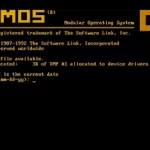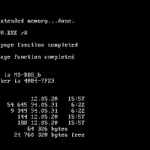Last Updated on: 10th November 2023, 04:37 pm
Web site: (not active)
Origin: USA
Category: Desktop
Desktop environment: CLI
Platform: MSX
Based on: MS-DOS
Wikipedia: MSX-DOS
Media: Install
The last version | Released: 2.30 | 1990
MSX-DOS – the disk operating system for MSX computers. It works with any version of MSX and can be operated on both the MSX1 and MSX2 without any problem. Disk operation on MSX is always done via MSX-DOS. This is also true concerning MSX DISK-BASIC, which uses BDOS calls for disk input/output. MSX-DOS and DISK-BASIC use the same disk format so that file conversion between BASIC and DOS is not necessary. This greatly increases operating efficiency and allows more effective use of file resources when MSX-DOS is used as the software development environment.
MSX is a standardized home computer architecture, announced by ASCII Corporation on June 16, 1983. It was initially conceived by Microsoft as a product for the Eastern sector, and jointly marketed by Kazuhiko Nishi, the director at ASCII Corporation.
MSX-DOS (ver 1.25) is a disk operating system for 16-bit personal computers, uses the same file format as MS-DOS. It is compatible with MS-DOS at the file level so that MSX-DOS can read and write files written on MS-DOS disks. In turn MS-DOS can read and write files created by MSX-DOS. Both disk operating systems use similar commands, so users who are familiar with MSX-DOS can easily use MS-DOS when upgrading to 16-bit machines.
MSX-DOS has system call compatibility with CP/M and can execute most programs created on CP/M without any modification. Most CP/M applications can thus be easily used with MSX-DOS. This opens up a large library of existing software which can be run on the MSX machines.
System requirements
To use MSX-DOS, a minimum configuration of 64K bytes RAM, a CRT, one disk drive, and a disk interface ROM is required. If less than 64K bytes RAM is installed, MSX-DOS cannot be used. MSX computers can only use MSX-DOS if they have 64K bytes RAM or more. Since MSX2 computers always have 64K bytes or more of RAM, they can always run MSX-DOS. A limited disk basic is used on those machines with less than 64K bytes RAM. Disk interface ROM is always supplied with the disk drive, and, on MSX machines with an internal disk drive, it resides inside the machine. For those machines using disk cartridges, it is in the cartridge.
System supported
MSX-DOS suppots up to eight disk drives. On a one-drive system, it has a 2-drive simulation feature (it uses one drive as two drives by replacing diskettes temporarily). It supports keyboard input, screen output, and printer output.
Media supported
MSX-DOS, which has a flexible file manager that does not depend on the physical structure of the disk, supports various media and uses 3.5 inch double density disks as standard. Either a one-sided disk called 1DD or two-sided disk called 2DD is used. Each of them uses either an 8-sector track format so four kinds of media can be used. The Microsoft formats for these four types are shown below.




